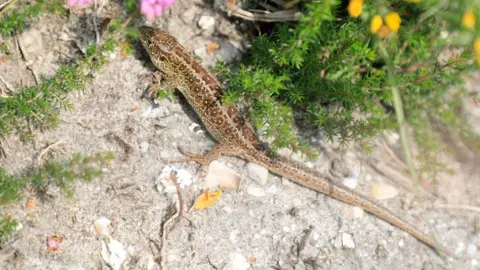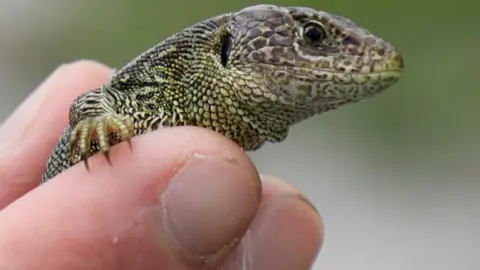Sand lizard releases in Dorset showing 'encouraging signs'
 Forestry England
Forestry EnglandThe release of rare sand lizards into the Dorset countryside is showing "promising signs" of creating established populations, conservationists have said.
About 200 were set free last year, and now a further 140 have been released at Forestry England sites.
Sand lizard numbers have diminished due to the loss of sandy lowland heath and coastal sand dune habitats.
Marwell Zoo ecologist Rachel Gardner said it had been an "encouraging year".
The lizards, which were bred at several locations including Marwell Zoo and Forestry England's New Forest Reptile Centre, have been released in a project led by Amphibian and Reptile Conservation (ARC).
 Forestry England
Forestry EnglandThe group said that despite an unfavourable spring, many of lizards had managed to lay two clutches of eggs.
The lack of prolonged hot or wet periods over the summer helped these to remain in good condition, prior to being excavated and incubated until hatching.
Once common in heathlands across southern England, habitat loss has meant sand lizards are now only found in a handful of sites.
Dorset is one of their key strongholds, with more than 70% of the remaining UK population.
'Critical species'
ARC's Nick Moulton said there had been an "encouragingly high" number of sand lizards released this year.
"It is still early days, but data from our introductions in Dorset over recent years is showing promising signs of ongoing breeding and the establishment of populations across a growing area," he said.
"The release of the next group of young sand lizards is another important milestone in continuing this recovery of a critical species."
Last year 200 of the reptiles were released into Puddletown Forest in the aftermath of the devastating forest fire at nearby Wareham Forest in which hundreds of sand lizards perished.

 Marwell Wildlife
Marwell WildlifeSand lizard facts:
- They live on protected heathland sites in Surrey, Dorset, Hampshire and in the protected Merseyside dunes
- They grow up to 20cm (7.8in) long and weigh about 15g (0.5oz)
- Both sexes have brown patterns down their backs with two stripes
- Their diet is mainly insects, spiders and grasshoppers

